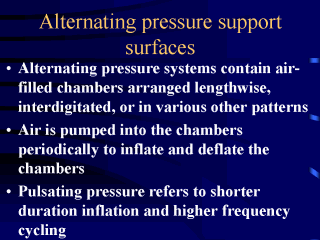 |
Alternating
pressure systems contain air-filled chambers or cylinders arranged lengthwise,
interdigitated, or in various other patterns. Air is pumped into the chambers at periodic
intervals to inflate and deflate the chambers in opposite phases thereby changing the
location of the contact pressure. Pulsating pressure differs from alternating therapy in
that the duration of peak inflation is shorter and the cycling time is more frequent. The
latter appears to have a dramatic effect on increasing lymphatic flow . The concept of
alternating pressure for prevention of tissue ischemia is not new. Kosiak concluded in
1961 that "since it is impossible to completely eliminate all pressure for a long
period of time, it becomes imperative that the pressure be completely eliminated at
frequent intervals in order to allow circulation to the ischemic tissue". Houle's
conclusion that a dynamic device that alternately shifts the pressure from one area to
another would be "the choice to provide adequate protection against the development
of ischemic ulcers" has been supported over the years by many others (Kosiak, 1976;
Souther, Carr & Vistnes, 1974; Seymour, 1985; . Rather than increasing the surface
area for distribution through immersion and envelopment, alternating pressure devices
distribute the pressure by shifting the body weight to a different surface contact area.
This may increase the interface pressure of that area during the inflation phase. |
